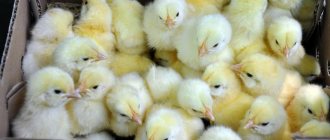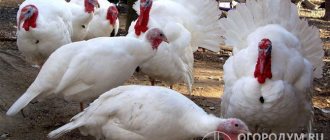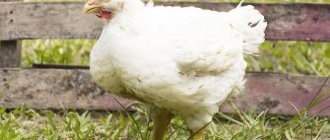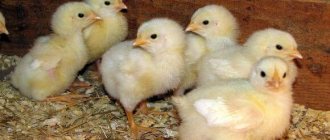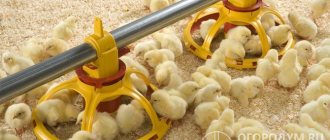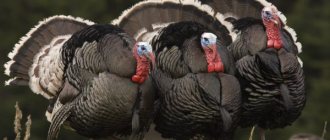Inexpensive and high-quality meat for your own needs or for sale can be obtained by raising broilers. If there are unused rooms on the site, they can be used by doing a little modernization. Raising broilers at home for beginning farmers requires special knowledge: how to choose the right breed or line, provide adequate nutrition for a certain type of chicken, what conditions and regimes are needed during different periods of chicken growth. These issues are discussed in detail in the following article.
Growing time
The profitability of raising broilers for meat determines the duration of their maintenance. The optimal period is up to 2 months. After the seventh week of bird growth, weight gain slows down, although broilers consume the same amount of feed as in the first stage of life.
To make matters worse, in the third month of cultivation, the pectoral muscles quickly grow and become fat. In order for chicks to gain sufficient body weight in the shortest possible time, it is necessary to feed complete broiler mixtures, thanks to which chicks can reach a weight of 2.8 kg in 5 weeks.
Broilers grow fastest between the first and fourth weeks of life, after which the growth rate decreases.
Suitable foods
At 1 month of age, broilers can be fed both dry food and wet mash.
The menu of one-month-old chickens must include wheat; various grain mixtures from oats, corn, peas, and barley are added to it.
Calcium-containing foods are added to this basic set: cottage cheese, boiled eggs. Fish ingredients containing iodine are often used. This could be the fish itself, waste from the fishing industry, or fish oil.
Feeding is carried out mainly with coarse grain. It is also not worth grinding additional ingredients too much.
The correct approach to feeding young animals is the key to their health
It is recommended to use a lot of greens for nutrition. For example, nettle, dill, and dandelion greens are suitable. Premixes containing essential microelements are added to grain crops.
After a month, broilers should be fed with yeast admixtures - this increases weight gain.
It is necessary to mix eggshells (of any poultry), ground chalk, a building element of bones, into the food.
Breed selection
For small-scale farming of broiler chickens in the country, it is better to choose chicken breeds based on their general type of utility. The exception is raising broilers as a business; here, with certain investments in premises and equipment, it is advisable to choose the most intensive breeds.
Broiler chickens are specially selected chicken lines characterized by much faster daily growth than purebred chickens and lower feed consumption per 1 kg of body weight.
By growing quickly and achieving significant weight in a shorter time, broilers become relatively cheap to produce. The following broiler breeds are often used for meat production:
- Ross 308
- Ross 508
- Ross 708
- Ross PM3,
- Cobb 500
- Hybro G+,
- Hybro PN+,
- Flex,
- F15,
- JA57.
According to reviews, the most popular broiler breeds for home growing technology are:
- Cobb 500,
- Ross 308,
- Flex.
Broilers were bred from the White Rock chicken line, which was female, and the Cornish line, which was male. To obtain broiler product lines, lighter mother breeds are used, connecting them with heavier males.
There is no perfect broiler line. Each breeder has his own way of using the potential of his herd to achieve maximum profit. Some may achieve high growth in one broiler line and others in another.
It is recommended to purchase broiler chickens (day-old or grown-up) from incubators.
Broiler chickens must have the following characteristics:
- fast growth rate;
- rapid achievement of the peak of average daily weight gain with low fatness;
- high slaughter productivity;
- good feed utilization and low consumption per 1 kg gain;
- ideal muscles of the chest, thighs;
- white plumage with white or yellow skin;
- fast plumage.
When wanting to buy chickens from the most intensive broiler lines that are more suitable for farm conditions, it is often forgotten that their growth potential is very high. This broiler requires:
- special living conditions;
- appropriate feeding;
- chicks quickly react to an unfavorable environment.
Why do broilers need medications?
Experienced poultry farmers know that even if all the rules of care and feeding are followed, chickens can get sick. To grow them to productive age and obtain high-quality meat, it is recommended to stock up on such drugs as:
- Prodevit is a multivitamin feed additive for chickens.
- Chiktonik is a therapeutic and prophylactic dietary supplement. Prescribed for vitamin deficiencies, metabolic disorders, stress, and also after the use of antibiotics.
- Vetom is a probiotic that improves metabolic processes and the body's immune defense. It is used in the prevention and treatment of coccidiosis and other diseases of birds. Useful for restoring the body after food intoxication.
- Gamavit is a veterinary immunomodulator. Prescribed for the treatment of any poisoning, anemia, and elimination of vitamin deficiency. Included in the complex of antibacterial therapy.
- Glucose. Its solution is used to strengthen the immune system of small chicks. Together with probiotics, vitamins and enzymes, glucose reduces the risk of inflammation in the gastrointestinal tract and promotes better digestion of food.
- Ascorbic acid. This is a vitamin C preparation that increases the overall tone and protective abilities of the body in chickens.
- Baytril, Baycox, Akolan, Enrofloxacin are antibiotics used for the treatment and prevention of coccidiosis, salmonellosis and other infectious diseases.
- Biovit-80 is an antibacterial drug of the tetracycline series, with vitamin B12. Used for the prevention and control of infections, stimulates the growth of chicks.
Any of the listed products can be purchased at a veterinary pharmacy, but their use must be agreed upon with a doctor.
Chicken coop - location, materials
When planning to place a chicken coop on your site, it is important to remember that chickens cannot tolerate:
- low temperature,
- high humidity,
- lack of oxygen.
Choose a place with a groundwater level no higher than 1 meter from the ground surface.
- Floor. The concrete base is poured. The floor level is made 20-30 cm above the ground level. Such a base will avoid problems with humidity and prevent gas exchange with the ground. The entrance to the broiler chicken coop is preferably located from the east.
- The walls are usually made of treated wood, brick or blocks, and the blocks are plastered. When breeding at home, wooden chicken coops are often built. Insulation, such as polystyrene, is placed between two layers of boards. The walls should be smooth on the inside - this will make cleaning easier and allow for thorough disinfection.
- Roof. A solid or gable roof is made of wood, PVC or tiles. Sheet metal is less suitable for a roof; it gets very hot in the summer and cools down quickly in the winter. A gutter is installed under the roof.
What not to feed
Often, inexperienced farmers try to feed broilers with high-calorie human food. You can't do this. At best, the chickens will become obese and the quality of the meat will suffer. At worst, part of the livestock will die as a result of diseases that develop against the background of excess body weight. To avoid adverse consequences, it is necessary to exclude harmful products from the diet of broilers:
- candies, cakes and other sweets;
- first courses with fatty meat broth;
- fresh bread and pastries;
- fresh milk;
- potato peelings;
- cheeses and sausage products;
- smoked, salted, dried fish;
- citrus.
Some housewives like to give their chickens table scraps. Such food spoils quickly, so it must be served immediately after harvesting.
Knowing what to feed broilers, even a novice poultry farmer can raise really large chickens. The main thing is to carefully study the recommendations discussed above and strictly follow them.
Preparing and disinfecting the chicken coop
The floors of the chicken coop are thoroughly cleaned to ensure that no organic waste remains. You can clean vertical and horizontal surfaces as quickly, conveniently and efficiently as possible using a high-pressure washer with hot water.
Thoroughly wash the entire chicken coop:
- floors;
- walls;
- poultry house equipment for watering and feeding;
- fans;
- inventory.
Cleaning should not be limited only to the chicken coop; it is important to clean the auxiliary premises - granaries, feed storage sheds.
After thorough cleaning of the interior, chemical disinfection is carried out. Here are some ways to treat your chicken coop.
- Disinfection with a 3% ammonia water solution.
- Perform fogging with 1 liter of formaldehyde per 200 cubic meters, and the temperature of the chicken coop during fogging should be at least 18 ˚C.
- Disinfection with 3% sodium hydroxide solution.
- Disinfection with 3% sodium hypochlorite solution.
When using chemical disinfection, it is important to choose the right chemicals and use them in accordance with the instructions, observing safety precautions. The products available on the market do not have a broad spectrum of action, so they must be used in combination to obtain the widest possible coverage.
For example:
- copper sulfate – has fungicidal activity;
- formaldehyde – bactericidal and virucidal;
- ammonia water - destroys oocysts.
Various types of garden sprayers are used to apply disinfectant solutions.
After disinfection, the chicken coop is hermetically sealed, the ventilation is turned off (closed) so that the active substances included in the solutions work effectively.
When washing and disinfecting poultry houses, all remnants of the last broiler breeding should be removed. Using slaked lime or caustic soda solution, disinfect the area surrounding the chicken coop and outbuildings, including paths.
After disinfection, the walls and floors are whitened with a solution of slaked lime, and the object is allowed to dry completely.
What commercial feeds are recommended for chickens?
For active weight gain, one-month-old broilers should be given the following commercial feed:
- Starter ones, which are given from the birth of the chicks until 14-30 days;
- fattening feed is given to broiler chickens after 30 days of life;
- finishers should be fed to broilers after 2 months of age and before slaughter.
You can also prepare feed for broilers at home.
After two months, broiler chickens can be fed wheat, green grass, vegetables and various fruits are added.
Growing conditions
From the first days of care, birds need fresh air. Ventilation is not only the correct temperature regime, but also the exchange of gases (CO₂ and oxygen).
Temperature conditions, lighting
It is best to start heating the coop 48 hours before introducing the chicks to 33-35°C on the day of introduction.
The coop temperature should be around 33 degrees during the first week of raising. The recommended temperature on the floor is about 30 degrees. Chickens do not yet have their own body thermoregulation. Then every week the temperature should be 3-4 degrees lower because the birds begin to produce more and more heat.
The feed is poured before the chicks are introduced. It is better to place the food on paper near the drinking bowls. The sound of pecking on paper will attract the chicks in the first days after settlement, so they will find food and water more easily.
Access to water should be easy, in addition to the standard equipping of the chicken coop with regular drinking bowls, you need to place drinking bowls for chickens.
All buildings must be equipped with lighting of at least 20 lux (with lighting fixtures on), measured at bird level, illuminating at least 80 percent of the area.
Check production results at least once a week. Depending on how the chicks are growing, appropriate lighting should be used. If birds grow too quickly, their bones and heart cannot bear the load, and they have difficulty standing on their feet. In this case, reduce the amount of light so that the chicks reduce their feed intake and slow down their growth slightly. Some breeders keep their chicks in the twilight.
It is advisable to use low light when factors such as the predisposition of the chicken breed, feed and coop equipment do not allow obtaining too high results in relation to the development rate of broilers.
If chickens are growing too quickly and their growth is much faster than their development, you need to provide them with proper living conditions or reduce their growth rate.
Humidity, ventilation
It is preferable when the air humidity is in the range of 60-70%.
Humidity levels play a significant role in chick development:
- Too high humidity means high thermal conductivity of the air. When a room becomes overheated or overcooled, it quickly causes a decrease in the bird's immunity. Pathogenic microorganisms reproduce better in humid conditions, which facilitate the transmission of some diseases.
- When the air is too dry, the mucous membranes of the upper respiratory tract dry out, under such conditions excess dust is formed - dry air also contributes to infections.
It is important to remember good air exchange. Proper ventilation allows you to maintain indoor temperature and humidity at optimal levels.
When installing any fan, it is important that the air speed measured at bird height does not exceed 0.6 m/s.
Good ventilation allows dust to be removed from the coop. Dusty air is dangerous for birds:
- dust attacks the respiratory system;
- irritates the conjunctiva of the eyes, causing inflammation.
The conditions for keeping broilers are spoiled by the gases formed as a result of the decomposition of manure: carbon dioxide, hydrogen sulfide, ammonia. These gases harm the bird:
- Ammonia is harmful to broilers in high concentrations. With good ventilation, the amount of ammonia should not exceed 25 ppm. Ammonia easily dissolves in water and leads to the formation of toxic fumes that irritate the conjunctivae of the eyes and the mucous membrane of the respiratory tract.
- Hydrogen sulfide accumulates with insufficient ventilation, directly above the floor. It is much more irritating than ammonia. The concentration of this gas should not exceed 10 parts per million.
Ventilation and heating should be operated to avoid overheating and maintain proper indoor humidity.
Noise levels should be kept to a minimum, so fans, feeders or other equipment should be designed, located, operated and maintained so that they cause minimal noise.
Chicken coop area
The number of chickens per unit area is an integral technological factor, along with the concentration of energy and protein in the feed. It equally determines the efficiency of broiler breeding along with nutrition.
The maximum stocking density when raising broilers in cages, on a farm, in a barn or other conditions cannot exceed 33 kg/m² at any time.
As the chickens grow, the area allocated for them in the chicken coop should increase. In the last period, the maximum stocking density is no more than 10 birds/m². Broilers raised in denser stockings may have dirty and damaged feathers, and the droppings may become too dense and wet.
Stocking density depends on the time of year - in summer there should be fewer chickens due to too high temperatures, which at high densities can lead to mass mortality.
Broiler housing density depends on many factors, the most important:
- bird access to water and food;
- expected final weight;
- duration of fattening;
- chicken health.
The optimal equipment is determined primarily by the technical equipment of the chicken coop, including the ventilation system. Inadequate housing conditions make chickens susceptible to disease.
How to choose potential record chickens
When purchasing incubation material, the poultry farmer should take into account that the weight of the future chick directly depends on the egg and accounts for 68% of its weight. At the same time, it is large in size, it can be lighter than average if there is a large air chamber under the shell.
Meat chickens are assessed for the future, 8-10 hours after their birth. Birds are examined on a table in a warm and bright room. Check:
- Mobility, reaction to loud sound (clap of hands). Weakened chicks are inactive and apathetic. For a control check, such individuals are separated from the rest and the clap is repeated.
- Body type. Take a small broiler in one hand, cover it with the palm of the other and feel the belly and residual yolk with your fingers. Then the quality of the down is assessed, as well as the condition of the legs, cloaca, umbilical cord, beak and eyes.
Promising chicks:
- active;
- give a reaction to sounds.
They have:
- soft, but not saggy belly;
- healed, without discharge, umbilical cord;
- clean cesspool;
- soft and silky down;
- clear, open eyes;
- closed beak;
- wings pressed to the body;
- short and strong legs;
- dense and elastic body.
The weight of a day-old broiler must be at least 35 g.
Stern
Broilers are characterized by very fast growth, efficient feed utilization, low fat content, high muscle to bone ratio, good meat quality.
Broiler chickens have a short digestive tract and fast metabolism, and therefore have high nutritional needs.
To produce a 1.35 kg broiler you need approximately:
- 4-5 weeks
- 2.5 kg of feed.
Fattening of broiler chickens is divided into 3-4 phases during 5-7 weeks of growing. The stages differ in the composition of the diet:
- at the first stage of feeding, chickens need a lot of protein per serving of feed (21-23%);
- at the final two stages, a high energy content is required (up to 13.4 MJ/kg).
Sometimes the average feed in terms of energy and protein is used throughout the fattening period, but the system of dividing the feed into phases and various mixtures is more effective.
Composition of feed mixtures
Broiler chicken mixtures are usually cereal based:
- wheat,
- triticale,
- barley,
- oats.
The use of rye is not recommended. Even a small addition of rye grain can cause diarrhea in chickens.
Compound feed for broilers often contains:
- by-products of grain grinding - feed flour, gluten, wheat germ;
- feed fats – vegetable oils, beef fat;
- pork, fish.
Feed may contain oilseeds - rapeseed, soybeans, and their post-extraction flour. The protein deficiency in the mixtures is compensated by the addition of high-protein seeds of narrow-leaved lupine and peas.
The list of ingredients of the mixtures includes additives:
- dry extracts;
- yeast;
- dry green food (from young grasses and alfalfa);
- fish flour;
- dairy products (milk powder, whey).
An important role in poultry feeding is mineral ingredients used to supplement micro- and macroelements. Commonly used:
- feed chalk;
- calcium phosphates;
- feed salt.
Most commercially available feeds contain feed additives designed to:
- replenishing the lack of certain ingredients (proteins, amino acids, vitamins);
- digestive support (feed enzymes);
- improving the digestibility and consistency of feed;
- reducing the toxicity of bird droppings;
- prevention of diseases (prebiotics).
Broiler chickens in the chicken coop must have constant access to feed and water.
Compound feed
Intensive rearing of broilers involves the use of modern feed in the diet. There are many types of food from different manufacturers.
In general, modern food is divided into:
- starters (for young chickens);
- basic (basic weight gain);
- finishing (used at the final stage of cultivation).
Table. Approximate calculation of the use of feed for broilers
| Feed group | Feeding period, days | Features of use |
| Starting | 0-10 | Should be given as soon as the chickens move into the coop. Birds should have easy access to water. |
| Grower I in crumb form | 10-24 | Used when birds reach 250-350 g body weight. Earlier use leads to excessive fat content and metabolic disorders, especially in the last period of fattening. |
| Grower II in granular form | 25-35 | |
| Finishing | last 7 days of growing |
Proper storage of feed
Chickens are good at recognizing feed quality, which can limit feed intake. Various factors affect broiler feed acceptance, including lack of palatable ingredients in the mixture, but the biggest problem is mycotoxins, which should be avoided. Mycotoxins are produced by some types of fungi and molds under appropriate conditions:
- temperature 20-25 °C;
- high humidity.
Toxic molds thrive in damp grain storage and are often carcinogenic and mutagenic organisms that cause anorexia in broilers.
Mycotoxins contribute to various diseases:
- acute and chronic intoxication;
- cause allergies;
- mycoses;
- diseases of the gastrointestinal tract and liver;
- numerous diseases associated with a weakened bird’s immune system.
It is very important to prevent diseases:
- store food correctly
- carry out periodic disinfection of storage facilities.
Granular or bulk feed - which is better?
Using granulated feed has a number of advantages:
- due to its homogeneity and high density, it allows you to consume it in larger quantities per unit of time - this ensures maximum productivity;
- accelerates the growth of broilers;
- granules do not spray, do not separate during storage and transportation - the feed is less contaminated with microorganisms;
- By consuming granulated feed (more energy-rich than bulk feed), broilers receive more energy and rest longer.
Maximum feed intake is achieved by feeding high quality pelleted mixtures.
However, the energy value and efficiency of use in broiler fattening depends on the quality of the granules.
The small size of the granules may reduce their taste.
Feed additives
Most feed additives used in feeding broiler chickens are also effective in pigs, both species are monogastric animals. A well-known phytase enzyme works in poultry and pigs, but most supplements are more effective in poultry, especially broilers.
Although very similar, the gastrointestinal tract of broilers is not the same as that of pigs. Therefore, the use of feed additives for chickens has its own peculiarities.
Finely ground feed improves the feeding efficiency of pigs, but disrupts digestion in broilers.
Some additives are most suitable for broilers, such as butyric acid.
What not to give to broilers
Meat crosses have a good appetite, but they are not omnivorous. It is forbidden to give poultry:
- bread crumbs, as well as baked goods with sweet filling;
- salted, pickled vegetables and other products containing spices, seasonings, sugar and large amounts of salt;
- waste from smoked meat and fish;
- boiled potatoes as a separate food. It is allowed exclusively in mash;
- fine sand, as it accumulates in the crop, clogging it;
- citrus fruit;
- sausages and cheeses;
- cocoa, coffee and chocolate;
- rotten, moldy and fermented foods;
- oil in a separate bowl.
Negligence in feeding matters leads to deterioration in the health of chickens. Their digestive tract may react with indigestion and diarrhea, which can negatively impact productivity. The chickens will become lethargic, lose their appetite, and lose weight.
